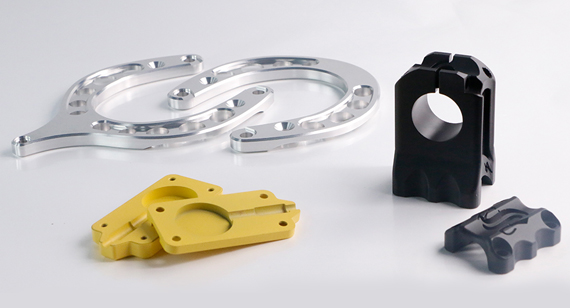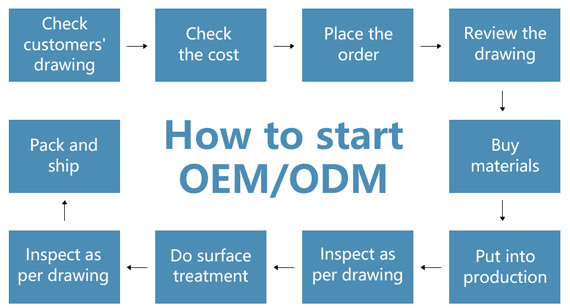
 2 |
Published by VMT at May 02 2024
2 |
Published by VMT at May 02 2024
In the field of CNC machining component manufacturing, customized machining of complex-shaped precision CNC components is both complex and intricate. It demands not only high levels of technical precision and machining stability but also the fulfillment of individualized requirements in terms of structure, shape, and dimensions. This article will delve into the process of achieving customized machining of complex-shaped precision CNC components, aiming to meet the readers' professional knowledge needs in this field.

I. The Value of Customized CNC Machining in Manufacturing Complex-Shaped Precision Components
Customized CNC machining plays a crucial role in the manufacturing of complex-shaped precision components. Through precise CNC programming and highly automated machining equipment, precise control over the shape, dimensions, and performance of components can be achieved. Compared to traditional machining methods, customized CNC machining offers higher precision, efficiency, and stability, meeting the special requirements of complex-shaped precision components during the manufacturing process.
CNC machining facilities, as vital places for implementing customized CNC machining, are typically equipped with advanced CNC machining equipment and professional technical teams. These facilities can provide full-process CNC machining services ranging from component design, process planning, programming to machining, and inspection based on specific customer requirements. Through in-depth communication with customers, CNC machining facilities ensure that design plans accurately reflect customer needs and expectations, achieving customized machining of components through professional machining techniques.

II. The Process of Customized Machining for Complex-Shaped Precision CNC Components
Achieving customized machining for complex-shaped precision CNC components requires following a rigorous process, including steps such as component drawing analysis, process planning, programming, program verification, workpiece clamping, machining operations, and quality inspection.
Firstly, in-depth analysis of component drawings is conducted to understand basic information such as the shape, dimensions, and materials of the components. Based on this information, a reasonable machining process plan is formulated, selecting appropriate machining equipment, tools, and fixtures, and determining machining parameters and routes. During the programming stage, professional CNC programming software is used to write correct machining programs based on component drawings and machining requirements. After program writing, simulation or trial cutting verification is performed to ensure the correctness and feasibility of the program.
Subsequently, the workpiece to be machined is placed on the fixture of the CNC machine tool for workpiece clamping. During clamping, it is essential to ensure the correct position and posture of the workpiece to avoid vibration and deformation during machining. Then, the verified program is input into the CNC machine tool, and machining commences. After machining is completed, the workpiece undergoes quality inspection to ensure it meets accuracy and performance requirements.

III. Key Technologies for Customized Machining of Complex-Shaped Precision CNC Components
In the process of customized machining for complex-shaped precision CNC components, several key technologies are crucial for achieving high precision and efficiency.
Firstly, tool selection and cutting parameter optimization are critical. Suitable tool types and cutting parameters are selected according to the specific requirements and machining conditions of the components. For internal space machining of components with complex shapes, methods such as tool radius compensation and tool chamfering can be used to achieve precise machining. Meanwhile, reasonable cutting speeds and feed rates are chosen based on the distribution of tangential and radial forces during machining to ensure excellent machining results.
Secondly, special clamping and positioning methods are required for components with complex shapes. Due to the complexity and irregularity of these components' shapes, vibrations and deformations are prone to occur during machining. Therefore, appropriate clamping methods, such as using vacuum suction cups or special fixtures, should be employed in the clamping device to ensure a stable machining process.
Furthermore, surface quality control is also crucial in customized machining of complex-shaped precision CNC components. For components with uneven surfaces, such as threads and gears, methods such as hobbing and quenching can be used for surface finishing. If it is necessary to maintain the original surface form of the components, grinding, polishing, and other processes can be used for final machining. Simultaneously, suitable measuring instruments and devices are used to inspect the dimensions, positions, and shapes of the components to ensure that the machining accuracy and surface quality meet requirements.
IV. Future Trends in Customized Machining of Complex-Shaped Precision CNC Components
With the continuous development of the manufacturing industry and technological advancements, the customized machining of complex-shaped precision CNC components will embrace broader development prospects. On one hand, as new materials and processes emerge, the application fields of complex-shaped precision CNC components will further expand. On the other hand, with the deep integration of technologies such as smart manufacturing and industrial internet, customized machining of complex-shaped precision CNC components will achieve higher levels of automation, intelligence, and personalization.
In the future, CNC machining facilities will focus more on technological innovation and talent cultivation, introducing advanced CNC machining equipment and process technologies to improve machining accuracy and efficiency. Meanwhile, strengthening communication and collaboration with customers, gaining in-depth understanding of customer needs and market changes, and providing customers with more accurate and efficient customized CNC machining services will be essential.
In conclusion, achieving customized machining of complex-shaped precision CNC components requires relying on advanced technology and equipment, following rigorous machining processes, and emphasizing the application of key technologies. Through continuous improvement of technical levels and service quality, CNC machining facilities will be able to meet customers' personalized requirements for complex-shaped precision CNC components, driving the continuous development of the manufacturing industry.
